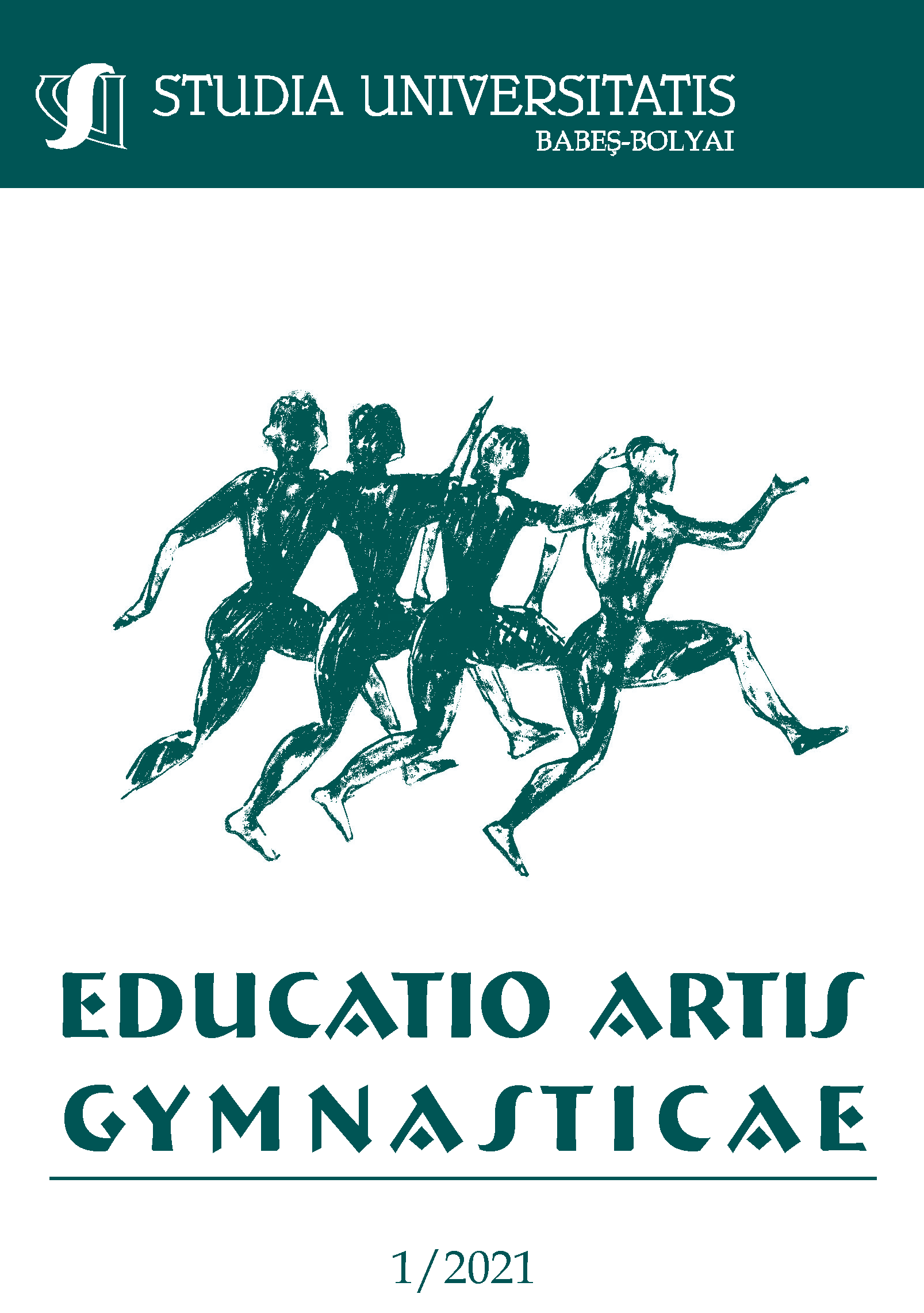DEVELOPING SPEED ENDURANCE THROUGH THE USE OF SMALL-SIDED FOOTBALL GAMES TO 16-18-YEAR-OLD JUNIORS
DOI:
https://doi.org/10.24193/subbeag.66(1).03Keywords:
small sided games, speed endurance, football, 16-18 years juniors.Abstract
Introduction. Training with small-sided games has proven to be effective in the training of football players. Objectives. The aim of this study was to analyze the effect of the participation of 16-18-year-olds in a small-sided football games program on speed-resistance (SE). Methods. The subjects of this study were 34 16-18-year-old sportsmen divided into two equal groups: Experiment group (EG) and control group (CG). Both groups participated in 18 workouts for 6 weeks – EG in a small-sided game content training program; CG in a training program structured on classic methods. The following equipment has been used: Hossand GT.a – to measure HRmax – and the WittyGate Microgate2. Subjects performed the YYIRTL1 and the 7x34.2 field test. The data collected was processed with the SPSS program, variant 23. Results. In the field test 7x34.2 there were no significant differences in the initial testing (IT) of the two groups, but in the final testing (FT) the differences were significant. The difference between the best time (BT) scores averages in the two groups was significant at FT (Mann-Whitney U = 39.5, N1 = 17, N2 = 17, two-tailed p = 0.000) and for the fatigue index averages (FI, U = 66.5, N1 = 17, N2 = 17, two-tailed p=0.007). Conclusions. The study revealed that through the application of a 6-week time program, in which small-sided football games were used, speed endurance developed.
REZUMAT. Dezvoltarea rezistenței în regim de viteză prin utilizarea jocurilor de fotbal pe teren redus la juniorii de 16-18 ani. Introducere. Antrenamentele cu jocuri pe teren redus s-au dovedit a fi eficiente în pregătirea fotbaliștilor. Obiectiv. Scopul acestui studiu a fost de a analiza efectul participării unor copii de 16-18 ani la un program de jocuri de fotbal pe teren redus asupra rezistenței în regim de viteză (RRV). Metode. Subiecții acestui studiu au fost 34 de sportivi de 16-18 ani împărțiți în două grupe egale: grupa experiment (GE) și grupa control (GC). Ambele grupe au participat la 18 antrenamente, timp de 6 săptămâni – GE la un program de antrenamente cu conținut de joc pe teren redus; GC la un program de pregătire structurat pe metode clasice. S-au folosit următoarele echipamente: Hossand Gt.a – pentru a măsura FCmax – și sistemul WittyGate Microgate2. Subiecții au efectuat testele YYIRTL1 și testul de teren 7x34,2. Datele colectate au fost prelucrate cu programul SPSS, varianta 23. Rezultate. La testul de teren 7x34,2 nu au fost diferențe semnificative la testarea inițială (TI) la cele două grupe, dar la testarea finală (TF) diferențele au fost semnificative. Diferența dintre mediile scorurilor celui mai bun timp (BT) la cele două grupe a fost semnificativă la TF (Mann-Whitney U = 39,5, N1 = 17, N2 = 17, two tailed p = 0,000) și pentru mediile indicelui de oboseală (FI, U = 66,5, N1 = 17, N2 = 17, two tailed p=0,007). Concluzii. Studiul efectuat a scos în evidență că prin aplicarea unui program periodizat de 6 săptămâni, în care s-au utilizat jocuri de fotbal pe teren redus, s-a dezvoltat rezistența în regim de viteză.
Cuvinte cheie: jocuri pe teren redus, rezistența în regim de viteză, fotbal, juniori 16-18 ani.
References
Aguiar, M., Botelho, G., Lago, C., Maças, V., & Sampaio, J. (2012). A Review on the Effects of Soccer Small-Sided Games. Journal of Human Kinetics, 33(1). doi.org/10.2478/v10078-012-0049-x
Balsom, P.D., Seger, J.Y., Sjodin, B., & Ekblom, B. (1992). Physiological responses to maximal intensity intermittent exercise. European Journal of Applied Physiology and Occupational Physiology, 65(2), 144–149. https://doi.org/10.1007/bf00705072
Balsom, P.D. (1999). Precision Football: Football Specific Endurance Training [EPub] (Vol.1). Retrieved from 58297078
Bangsbo, J. (2007). Aerobic and Anaerobic Training in Soccer: fitness training in soccer I. Stormtryk.
Bangsbo, J. (2008). Entrenamiento de la condicion fisica en el futbol (Deportes) (Spanish Edition) (4th ed.). Paidotribo.
Clemente, F.M., Lourenço Martins, F.M., & Mendes, R.S. (2014). Developing Aerobic and Anaerobic Fitness Using Small-Sided Soccer Games. Strength and Conditioning Journal, 36(3), 76–87. https://doi.org/10.1519/ssc.0000000000000063
Dellal, A., Chamari, K., Owen, A.L., Wong, D.P., Lago-Penas, C., & Hill-Haas, S. (2011). Influence of technical instructions on the physiological and physical demands of small-sided soccer games. European Journal of Sport Science, 11(5), 341-346. doi.org/10.1080/17461391.2010.521584
Drust, B., Reilly, T., & Cable, N.T. (2000). Physiological responses to laboratory-based soccer- specific intermittent and continuous exercise. Journal of Sports Sciences,18(11), 885–892. https://doi.org/10.1080/026404100750017814
Hill-Haas, S.V, Rowsell, G.J., Dawson, B.T., & Coutts, A.J. (2009). Acute Physiological Responses and Time-Motion Characteristics of Two Small-Sided Training Regimes in Youth Soccer Players. Journal of Strength and Conditioning Research, 23(1), 111–115. https://doi.org/10.1519/jsc.0b013e31818efc1a
Hoff, J. (2002). Soccer specific aerobic endurance training. British Journal of Sports Medicine, 36(3), 218–221. https://doi.org/10.1136/bjsm.36.3.218
Impellizzeri, F., Marcora, S., Castagna, C., Reilly, T., Sassi, A., Iaia, F., & Rampinini, E. (2006). Physiological and Performance Effects of Generic versus Specific Aerobic Training in Soccer Players. International Journal of Sports Medicine, 27(6), 483–492.https://doi.org/10.1055/s-2005-865839
Katis, A., & Kellis, E. (2009). Effects of small-sided games on physical conditioning and performance in young soccer players. Effects of Small-Sided Games on Physical Conditioning and Performance in Young Soccer Players, 8(3), 374–380. Retrieved from PMC3763282
Reilly, T., & Gilbourne, D. (2003). Science and football: a review of applied research in the football codes. Journal of Sports Sciences, 21(9), 693–705. doi.org/10.1080/0264041031000102105
Spencer, M., Bishop, D., Dawson, B., & Goodman, C. (2005). Physiological and Metabolic Responses of Repeated-Sprint Activities. Sports Medicine, 35(12), 1025–1044. https://doi.org/10.2165/00007256-200535120-00003
Weineck, J. (1988). La preparazione fisica ottimale del calciatore. Calzetti Mariucci.
Wilmore, J.H., & Costill, D.L. (2002). Physiologie du sport et de l’exercice. De Boeck.
Downloads
Published
How to Cite
Issue
Section
License
Copyright (c) 2021 Studia Universitatis Babeș-Bolyai Educatio Artis Gymnasticae

This work is licensed under a Creative Commons Attribution-NonCommercial-NoDerivatives 4.0 International License.



